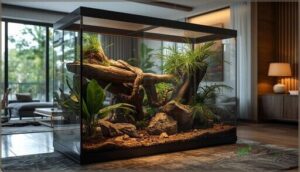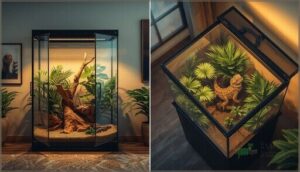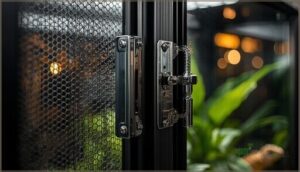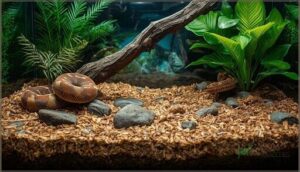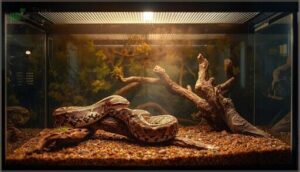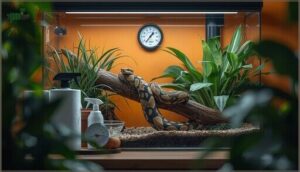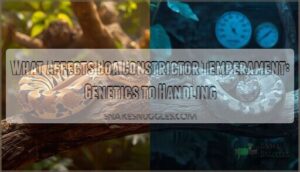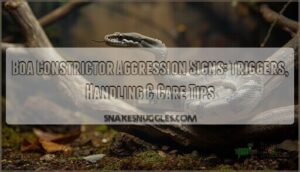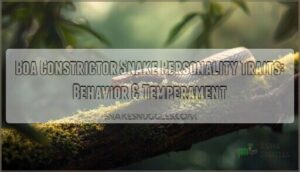This site is supported by our readers. We may earn a commission, at no cost to you, if you purchase through links.
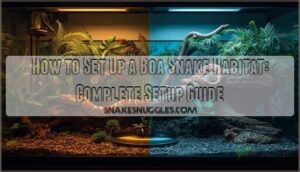
Your boa constrictor won’t thrive in a “good enough” setup—it needs an environment that mirrors the thermal gradients, humidity zones, and structural complexity of its natural range. Too many new keepers underestimate how precisely these snakes regulate their body temperature, leading to poor appetite, respiratory infections, and chronic stress.
A proper boa snake habitat setup isn’t about filling a tank with decorations. It’s about engineering microclimates your snake can move between throughout the day. You’ll need to balance heat sources, control humidity without creating stagnant air, and provide enough secure hiding spots to make a naturally cautious ambush predator feel safe.
Get these fundamentals right from day one, and you’ll avoid the costly corrections that plague hasty setups.
Table Of Contents
Key Takeaways
- Your boa needs precise thermal gradients (90–95°F basking, 75–80°F cool side) and humidity control (55–75% ambient, rising to 75–85% during shedding) to support proper digestion, immune function, and respiratory health—getting these wrong leads to chronic infections and poor appetite.
- Enclosure size must match your boa’s growth trajectory from the start, with adults requiring at least 6 x 3 x 3 feet, and PVC materials outperform glass or wood by retaining heat efficiently while resisting the moisture damage that causes mold and structural failure.
- Your substrate depth should increase with your boa’s age (1–2 inches for neonates, 4–6 inches for adults), and you’ll need at least two hides positioned in different temperature zones to allow natural thermoregulation and reduce stress-related behaviors by 30%.
- Daily spot-cleaning combined with weekly deep cleans using reptile-safe disinfectants and complete substrate replacement every 3–4 months prevents bacterial buildup and mold growth, which are the primary causes of preventable health issues in captive boas.
Choosing The Right Enclosure
Your boa’s enclosure is more than just a container—it’s the foundation of their entire environment. Getting the size, material, and design right from the start prevents stress and costly upgrades down the road.
Here’s what you need to know about choosing an enclosure that works for both you and your snake.
Recommended Enclosure Sizes for Boas
When selecting enclosure size, start with your boa’s current length and expected adult size. A baby under 2 feet needs at least 2 x 1.5 x 1 feet, while juveniles (2–5 feet) require 4 x 2 x 2 feet minimum. Adults measuring 6–8 feet demand 6 x 3 x 3 feet or larger.
Growth considerations matter—most boas triple in size by age three, so plan ahead to avoid repeated upgrades.
These snakes benefit from arboreal enrichment to encourage natural behaviors.
Best Enclosure Types and Materials
Your enclosure material choice impacts everything from temperature control to long-term durability. PVC durability stands out—it resists moisture, retains heat effectively, and simplifies cleaning. Wood insulation helps maintain stable temperatures but requires waterproofing in humid setups, or you’ll risk mold.
Glass visibility offers clear observation but accumulates condensation and weighs considerably more. Avoid melamine risks entirely; it deteriorates rapidly under humidity, compromising your boa’s health and safety.
PVC enclosures are also popular because they’re trusted by reptile keepers.
Front-Opening Vs Top-Opening Designs
Your enclosure design affects both access safety and cleaning efficiency. Front-opening enclosures reduce the predatory “swooping” perception that top openings create, minimizing stress during handling. They also simplify maintenance without disturbing humidity levels.
Consider these practical advantages:
- Spatial suitability: Front doors accommodate taller, climb-friendly setups
- User preference: Experienced keepers consistently favor front access for long-term boa care
- Escape risks: Properly secured front openings with strong locks prevent common escape scenarios
Safe enclosure security starts with thoughtful design choices.
Secure Locks and Escape Prevention
Heavy-duty wire locks with reinforced steel components provide the strongest line of defense against escape attempts. You’ll want multiple lock types—slide locks paired with padlocks—since incident reports show this combination greatly reduces escapes.
Regular lock maintenance matters just as much as material strength. Check seals and block potential escape routes with steel mesh or solid panels.
For added protection, some keepers install alarm systems that alert them to unauthorized openings, creating a truly safe and secure environment.
Temperature and Humidity Control
Getting the temperature and humidity right isn’t just about keeping your boa alive—it’s about helping it thrive. These two factors work hand in hand to support everything from digestion to healthy shedding.
Let’s break down exactly how to create and maintain the conditions your boa needs.
Creating Effective Temperature Gradients
Temperature gradients let your boa thermoregulate naturally, moving between warm and cool zones as needed. Position your heat source at one end to create a warm basking area of 90–95°F and a cooler retreat of 75–80°F.
This 10–15°F difference aids digestion, metabolism, and natural behavior. Monitor both ends with digital thermometers and make seasonal adjustments to mirror their wild habitat.
Heating Equipment and Thermostat Use
Reliable heating equipment keeps your temperature gradient steady and safe. Use halogen heat bulbs or ceramic heat emitters suspended above the enclosure, paired with a proportional thermostat for precision control and energy efficiency. This setup prevents burns and maintains basking temperatures between 86–90°F during the day.
Key components include:
- Halogen or ceramic heating elements positioned overhead for natural heat distribution
- Calibrated thermostats with auto-dimming to protect your boa and extend bulb life
- Adequate basking area size covering enough surface for your boa’s entire body to warm evenly
Monitor nighttime temperatures—they can drop to 68–80°F safely.
Maintaining Optimal Humidity Levels
Regarding humidity control, your boa thrives at 55–75% ambient humidity, rising to 75–85% during shedding support. This ideal humidity range promotes respiratory health and prevents stuck sheds.
Methods to maintain humidity include misting techniques using coco substrate or timed foggers, plus humid hides lined with damp sphagnum moss.
Balance moisture with ventilation to avoid mold—stagnant air above 80% risks fungal infections.
Monitoring Tools: Thermometers and Hygrometers
You can’t manage what you can’t measure—accurate monitoring prevents health disasters. Digital hygrometers outperform analog models in accuracy comparison, while infrared guns measure surface temperature and probe placement matters for gradient readings.
Position one thermometer at the basking spot, another at the cool end. Integrate your thermostat with remote monitoring systems that alert you to dangerous swings. Calibrate sensors monthly to maintain reliable temperature ranges and humidity tracking.
Substrate and Decoration Options
Your choice of substrate and decorations directly impacts your boa’s health, comfort, and behavior. The right materials help maintain humidity, support natural movements, and reduce stress.
Let’s break down the best options for creating a functional and enriching environment.
Safe Substrate Choices for Boas
Your substrate choices for boas directly impact their health and your maintenance workload. Natural substrates like coconut fiber and cypress mulch retain humidity well, though cypress carries impaction risks for young snakes.
A DIY mix of 40% topsoil, 40% ReptiSoil, and 20% play sand offers ideal safety. Avoid pine and cedar—their oils harm respiratory systems.
Paper bedding works but requires frequent cleaning.
Ideal Substrate Depth by Age
Choosing substrate depth correctly gives your boa the environment it needs throughout its life. Neonate substrate should stay shallow—1 to 2 inches—for easy monitoring and cleaning. Juvenile boas need 2 to 4 inches as they grow and explore more. Adult boas thrive with 4 to 6 inches, supporting adult burrowing behavior and humidity balance.
Proper depth directly affects health impact, respiratory function, and shedding success.
Climbing Branches and Platforms
Your boa’s arboreal lifestyle depends on sturdy climbing branches and platforms. Climbing structures offer enrichment benefits by promoting muscle tone and reducing stress through natural climbing behavior.
Material selection matters—choose mopani, cork bark, or manzanita for branch stability and mold resistance. Incorporating climbing branches in thoughtful spatial design maximizes vertical space.
Match branch diameter to your boa’s body thickness for secure grip and climbing opportunities.
Hiding Spots and Visual Barriers
Secure hides offer more than shelter—they provide stress reduction and thermoregulation benefits your boa needs. Place at least two hiding spots, one on each temperature zone, to support behavioral changes tied to habitat enrichment.
Design considerations matter: choose snug, body-sized hides using cork bark or coconut fiber. Visual barriers like foliage reduce defensive posturing by up to 30%, improving overall comfort.
Live and Artificial Plant Benefits
Adding plants and foliage transforms enclosure decor and features while creating a naturalistic environment your boa benefits from daily. Both live plants and artificial plants offer distinct advantages:
- Humidity regulation – Live plants boost ambient moisture through transpiration
- Behavioral enrichment – Climbing surfaces reduce stress and boredom
- Plant durability – Artificial options withstand heavy snakes without damage
- Toxicity concerns – Choose non-toxic species like pothos or pesticide-free fakes
- Aesthetic impact – Combine both types for visual appeal and practical function
Lighting and Ventilation Needs
Your boa doesn’t need elaborate lighting like some reptiles, but getting the basics right matters for their daily rhythm and your ability to monitor their health.
Ventilation is just as important—it keeps the air fresh and prevents the kind of stagnant conditions where mold and respiratory issues thrive.
Let’s break down what your setup actually needs to keep your boa comfortable and healthy.
Appropriate Lighting Types and Cycles
Lighting considerations for boas center on mimicking natural day and night cycles without nocturnal disruption. You’ll want halogen basking lamps paired with T5 HO fluorescent UVB bulbs positioned 10-14 inches above mesh to achieve proper UVB intensity.
Set your lighting duration to 12 hours on, 12 hours off during most months, adjusting seasonal lighting slightly—13 hours in summer, 11 in winter—to support natural rhythms.
Benefits of UVB and LED Lighting
While proper lighting considerations for boas might seem optional, UVB exposure actually facilitates vitamin D3 synthesis, strengthening calcium absorption and immune function. LED lighting complements this by regulating circadian rhythms and behavioral health through natural photoperiods.
Together, they improve coloration impact and energy efficiency in your setup. This lighting cycle combination bolsters your boa’s physiological needs while minimizing long-term costs.
Ventilation Methods for Healthy Airflow
Because boas depend on fresh oxygen for lung ventilation even during constriction, proper enclosure ventilation considerations directly protect respiratory health and control mold growth.
Effective airflow systems balance these lighting and ventilation needs:
- Screened lids or mesh panels guarantee consistent air flow while preventing escape
- Cross-ventilation design locates intake vents on the cool side, exhaust near warmth, creating airflow gradients
- Mesh density selection balances security with VOC reduction and adequate oxygen exchange
- Strategic vent placement avoids drafts that stress your boa
- Seasonal adjustments modify airflow during shedding or temperature shifts
Preventing Drafts and Mold Growth
While effective ventilation strategies maintain air flow, sealing enclosures against drafts requires adhesive foam strips or silicone gaskets around doors to prevent stress-inducing airflow.
Humidity control between 55-75% with intermittent misting prevents mold growth on substrate and decor. Monitor humidity balance using digital hygrometers, and place vents strategically—low on cool sides, high near warmth.
Regular mold identification during spot-cleaning aids maintenance protocols that keep your boa healthy.
Essential Care and Maintenance Tips
Setting up your boa’s habitat is just the beginning—keeping it clean and well-maintained is what truly makes the difference in your snake’s health. Daily checks and routine cleaning prevent problems before they start, while careful monitoring helps you catch potential issues early.
A clean, well-maintained habitat isn’t optional—it’s what keeps your boa healthy and catches problems before they escalate
Let’s break down the essential tasks that’ll keep your boa thriving in its environment.
Water Bowl Placement and Sizing
Your boa’s water bowl setup directly influences hydration, shedding success, and overall health. Choose a bowl material like ceramic or stainless steel that resists tipping and simplifies cleaning frequency.
Place the water source on the cooler side to slow evaporation while ensuring your snake can access it easily.
Size matters—water bowls should allow partial soaking benefits without crowding the enclosure or creating maintenance headaches.
Cleaning and Substrate Replacement Schedule
You’ll want to deep clean your boa’s enclosure weekly using a reptile-safe disinfectant or 3% bleach solution, letting it sit for 10 minutes before rinsing thoroughly. Replace substrate completely every 3 to 4 months to maintain proper substrate depth and prevent mold growth. Bioactive setups require less frequent changes but still need monitoring.
Daily waste removal controls odor and keeps your enclosure cleaning manageable between full replacements.
Spot-Cleaning and Deep Cleaning Procedures
Daily waste removal is your frontline defense against bacteria and odors. Use a scoop to lift out feces and soiled substrate immediately, then wipe surfaces with reptile-safe disinfectant solutions.
For deep cleans, remove your boa, discard old substrate, scrub all decor and surfaces, and let a 10% bleach solution sit for 10–15 minutes. Rinse thoroughly, dry completely to prevent mold, and maintain cleaning frequency records for consistent enclosure maintenance.
Monitoring for Health and Shedding Issues
Beyond cleaning routines, you need to check your boa’s wellbeing regularly. Shedding Frequency in healthy adults occurs 4–5 times yearly, requiring Humidity Levels near 70–85% during each shedding period.
Watch for Behavioral Changes like lethargy or appetite loss—stress signs that demand attention. Physical Inspections twice daily catch dull scales or retained skin early.
Preventative Care through environmental control aids snake health far better than reactive treatments.
Frequently Asked Questions (FAQs)
How often should I handle my boa snake?
You should handle your boa 1-2 times weekly to maintain tameness. Start with brief 5-minute sessions, gradually increasing to 10-15 minutes as your snake becomes comfortable.
Always avoid handling during shedding or 48 hours post-feeding.
What feeding schedule works best for boas?
Juvenile feeding works best every 5 to 7 days, while adult intervals stretch to 10 to 14 days. Prey size should match your boa’s girth, supporting proper digestion health and steady growth.
Can boas live together in one enclosure?
No, boas shouldn’t live together. Cohabitation stress, territorial tendencies, and cannibalism risks make it dangerous.
Expert opinions warn against it due to aggression, breeding concerns, and space limitations preventing safe separation during feeding.
What signs indicate my boa is stressed?
Watch for defensive behaviors like hissing or tight coiling, prolonged tongue flicking, feeding refusal, and shedding issues. Muscle tension, restlessness, or mock striking also signal stress.
Proper environmental enrichment aids stress reduction in snakes.
Do boas need veterinary checkups and how often?
Like taking your car in for tune-ups, your boa constrictor needs annual veterinary checkups for exam frequency, parasite screening, and IBD prevention.
Home monitoring between visits ensures reptile health and wellness, catching issues early.
Conclusion
Ironically, the “simple” pet snake demands one of the most complex environments you’ll engineer. Your boa snake habitat setup either functions as a cohesive thermal ecosystem or becomes a slow-motion health crisis.
Miss the gradient by five degrees, let humidity drift, or skip that second hide—and you’re troubleshooting problems for months.
But nail these fundamentals now, and maintenance becomes routine. Your boa won’t thank you, but its steady feeding response and perfect sheds will.
- https://reptifiles.com/dumerils-boa-care/enclosure-size/
- https://www.reddit.com/r/snakes/comments/1gsyceo/what_size_tank_is_recommended_for_an_adult_boa/
- https://www.knobcreeknaturalist.com/blog/boa-constrictor-temperature-and-humidity-requirements
- https://www.youtube.com/watch?v=3UZb-xtWg3w
- https://www.thebiodude.com/blogs/reptile-and-amphibian-caresheets-with-cited-veterinary-and-herpetology-sources/boa-constrictor-care-guide-and-bioactive-terrarium-maintenance?srsltid=AfmBOorENJVrML3S-LGXlZngUsVYrbtrsrR7B77Kk518zH5LfB6gnD3y

